INSTITUT SUPERIEUR D'ANTHROPOLOGIE
INSTITUTE OF ANTHROPOLOGY
ONLINE COURSES / COURS A DISTANCE
FALL TERM : OCTOBER 2015
REGISTER NOW
BELGIQUE – 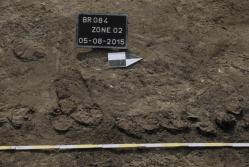 Bruxelles - Alors que des ouvriers s'activaient sur un chantier, une découverte archéologique d'importance a été faite sur le site de Tour & Taxis. Des restes d’un aménagement en bois, localisé sur un ancien bras de la Senne inconnu jusqu’à ce jour, ont été mis au jour. Les objets archéologiques permettent de dater cet aménagement à l’époque romaine (IIe-IIIe siècles). "Il s’agit d’une découverte majeure pour l’histoire de la Région bruxelloise. En effet, outre quelques découvertes isolées (monnaies, matériaux de construction et céramiques), seules quelques villas (exploitations agricoles), datant de la même époque, sont connues sur le territoire de la Région, notamment à Anderlecht, Jette et Laeken. Grâce à cette découverte, un nouveau pan de l’histoire romaine de la Région pourra donc être écrit", annonce dans un communiqué le département public de la Direction des Monuments et des Sites . Cet organe bruxellois a dépêché sur les lieux une équipe archéologique afin d’enregistrer les vestiges avant leur disparition. L'équipe de scientifiques a jusqu'au 14 août pour effectuer ses recherches.
Bruxelles - Alors que des ouvriers s'activaient sur un chantier, une découverte archéologique d'importance a été faite sur le site de Tour & Taxis. Des restes d’un aménagement en bois, localisé sur un ancien bras de la Senne inconnu jusqu’à ce jour, ont été mis au jour. Les objets archéologiques permettent de dater cet aménagement à l’époque romaine (IIe-IIIe siècles). "Il s’agit d’une découverte majeure pour l’histoire de la Région bruxelloise. En effet, outre quelques découvertes isolées (monnaies, matériaux de construction et céramiques), seules quelques villas (exploitations agricoles), datant de la même époque, sont connues sur le territoire de la Région, notamment à Anderlecht, Jette et Laeken. Grâce à cette découverte, un nouveau pan de l’histoire romaine de la Région pourra donc être écrit", annonce dans un communiqué le département public de la Direction des Monuments et des Sites . Cet organe bruxellois a dépêché sur les lieux une équipe archéologique afin d’enregistrer les vestiges avant leur disparition. L'équipe de scientifiques a jusqu'au 14 août pour effectuer ses recherches.
http://www.lalibre.be/regions/bruxelles/decouverte-archeologique-majeure-pour-l-histoire-de-la-region-bruxelloise-55c366e43570b54653231216
TURQUIE – 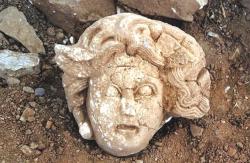 Antiocheia Ad Cragum - The head of Medusa, a Greek mythological creature who turned all that gazed upon her into stone, has been unearthed during excavations in the ancient city of Antiocheia Ad Cragum in the southern province of Antalya’s Gazipaşa district. “We have found the Medusa figure ... among the marble blocks of a big structure, most probably a temple,” said Nebraska University’s Michael Hof, who is heading the excavations. “This is a normal human-size head, maybe a bit bigger. It does not belong to a sculpture but a relief located in the front façade of the temple. It was found nearly a week ago. When the excavation is finished, it will be delivered to the Alanya Cultural Directorate.”
Antiocheia Ad Cragum - The head of Medusa, a Greek mythological creature who turned all that gazed upon her into stone, has been unearthed during excavations in the ancient city of Antiocheia Ad Cragum in the southern province of Antalya’s Gazipaşa district. “We have found the Medusa figure ... among the marble blocks of a big structure, most probably a temple,” said Nebraska University’s Michael Hof, who is heading the excavations. “This is a normal human-size head, maybe a bit bigger. It does not belong to a sculpture but a relief located in the front façade of the temple. It was found nearly a week ago. When the excavation is finished, it will be delivered to the Alanya Cultural Directorate.”
http://www.hurriyetdailynews.com/head-of-medusa-found-in-antalya-.aspx?pageID=238&nid=86544&NewsCatID=375
USA – 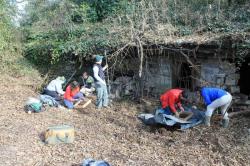 Black Cat Cave - Well known among Rutherford County locals as the reputed location of a speakeasy during the 1920s Prohibition Era, Black Cat Cave recently became the subject of an archaeological excavation by a team of MTSU professors and students. Conducted in spring 2014, the MTSU field study came soon after the city discovered vandalism and heavy looting of the cave, including graffiti and illegal digging. The university's study confirmed the presence of a prehistoric cemetery at the site, contradicting historians and archaeologists' previous understanding of the area. Through radiocarbon dating the human artifacts and human remains recovered were determined to date back 5,000-7,500 years, to what is known as the Middle Archaic Period. "The discovery of ancient human remains within the confines of Black Cat Cave has required sensitivity to the peoples and rituals of the ancient past," said MTSU archaeologist Shannon Hodge. "As a scholar of prehistoric culture, I appreciate the efforts of the City of Murfreesboro to protecting and preserving this cultural resource. Traditionally, historians and archaeologists believed that for thousands of years much of Rutherford County was a "no-man's-land" between neighboring groups, used simply as a hunting ground. But this site proves that prehistoric people lived and thrived in the rich environment and abundant natural resources in the county, Hodge said. In its natural state, Black Cat Cave had a 5-6 foot limestone shelf, which formed a horizontal opening, approximately 120 feet in length. During more modern history, the cave's opening was barricaded with boulders and a failing, aged fence for safety. The boulders and fence have been removed and replaced with the new design. In addition to modern artifacts, like glass fragments from the cave's speakeasy days, the 2014 dig and screening uncovered stone artifacts and other evidence from the Middle Archaic Period. The evidence also includes ancient remains of freshwater mussel and snail shells brought into the cave and discolored soil layers, which indicate human activity such as a hearth for a fire. "Despite previous historical writings to the contrary, this new evidence shows that people lived in what is now Rutherford County for thousands of years," added Peres. "This is a rich prehistoric cultural past in Rutherford County that we are just beginning to understand." Peres has studied other prehistoric sites in Rutherford County, including what is known as the Magnolia Valley Site in the southwestern corner of the county. The site at Black Cat Cave will help tell part of the story of prehistoric occupation in the area and could expand understanding of how it was used by prehistoric people.
Black Cat Cave - Well known among Rutherford County locals as the reputed location of a speakeasy during the 1920s Prohibition Era, Black Cat Cave recently became the subject of an archaeological excavation by a team of MTSU professors and students. Conducted in spring 2014, the MTSU field study came soon after the city discovered vandalism and heavy looting of the cave, including graffiti and illegal digging. The university's study confirmed the presence of a prehistoric cemetery at the site, contradicting historians and archaeologists' previous understanding of the area. Through radiocarbon dating the human artifacts and human remains recovered were determined to date back 5,000-7,500 years, to what is known as the Middle Archaic Period. "The discovery of ancient human remains within the confines of Black Cat Cave has required sensitivity to the peoples and rituals of the ancient past," said MTSU archaeologist Shannon Hodge. "As a scholar of prehistoric culture, I appreciate the efforts of the City of Murfreesboro to protecting and preserving this cultural resource. Traditionally, historians and archaeologists believed that for thousands of years much of Rutherford County was a "no-man's-land" between neighboring groups, used simply as a hunting ground. But this site proves that prehistoric people lived and thrived in the rich environment and abundant natural resources in the county, Hodge said. In its natural state, Black Cat Cave had a 5-6 foot limestone shelf, which formed a horizontal opening, approximately 120 feet in length. During more modern history, the cave's opening was barricaded with boulders and a failing, aged fence for safety. The boulders and fence have been removed and replaced with the new design. In addition to modern artifacts, like glass fragments from the cave's speakeasy days, the 2014 dig and screening uncovered stone artifacts and other evidence from the Middle Archaic Period. The evidence also includes ancient remains of freshwater mussel and snail shells brought into the cave and discolored soil layers, which indicate human activity such as a hearth for a fire. "Despite previous historical writings to the contrary, this new evidence shows that people lived in what is now Rutherford County for thousands of years," added Peres. "This is a rich prehistoric cultural past in Rutherford County that we are just beginning to understand." Peres has studied other prehistoric sites in Rutherford County, including what is known as the Magnolia Valley Site in the southwestern corner of the county. The site at Black Cat Cave will help tell part of the story of prehistoric occupation in the area and could expand understanding of how it was used by prehistoric people.
http://www.murfreesboropost.com/native-american-site-discovered-secured-at-black-cat-cave-cms-42565
TURQUIE –  Hoşap Castle - Excavation and restoration works at the Hoşap Castle in the eastern province of Van’s Gürpınar district, have revealed 250-year-old cheese. Works have been carried out in the castle, which was built in the 16th century on the foundation of an Urartian castle and served as a palace for many years, by a team of people from Van Yüzüncü Yıl University’s department of Art History. The recent work in the castle has unearthed cheese in four different cubes. The cheese was sent to the university’s chemistry lab for examination. The head of the excavations, assistant professor Mehmet Top, said that one of the four cubes used in the kitchen of the castle was found broken. “One of the methods to keep Van’s famous herbed cheese is to bury it underground in these cubes. This tradition still continues. We have proved it archaeologically during the Hoşap Castle excavations. The cheese was calcified and deposited in the cubes. We can say that it is from 200-250 years ago,” he said. He said that the cubes were also covered with earth, adding that they had found the remaining organic substances in the cheese, which would be examined by both chemistry and food engineers.
Hoşap Castle - Excavation and restoration works at the Hoşap Castle in the eastern province of Van’s Gürpınar district, have revealed 250-year-old cheese. Works have been carried out in the castle, which was built in the 16th century on the foundation of an Urartian castle and served as a palace for many years, by a team of people from Van Yüzüncü Yıl University’s department of Art History. The recent work in the castle has unearthed cheese in four different cubes. The cheese was sent to the university’s chemistry lab for examination. The head of the excavations, assistant professor Mehmet Top, said that one of the four cubes used in the kitchen of the castle was found broken. “One of the methods to keep Van’s famous herbed cheese is to bury it underground in these cubes. This tradition still continues. We have proved it archaeologically during the Hoşap Castle excavations. The cheese was calcified and deposited in the cubes. We can say that it is from 200-250 years ago,” he said. He said that the cubes were also covered with earth, adding that they had found the remaining organic substances in the cheese, which would be examined by both chemistry and food engineers.
http://www.hurriyetdailynews.com/centuries-old-cheese-found-in-van-castle-.aspx?pageID=238&nID=86489&NewsCatID=375
TURQUIE – 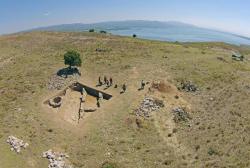 Kaymakçı Hill - In Gölmarmara Lake of Turkey’s Aegean province of Manisa, archaeology excavation findings are about to bring to light the late Bronze Age (1600 - 1200 B.C.). The international excavation team consisting of 42 archaeologists from U.S., Europe and Turkey’s universities have been working on the Kaymakçı Hill in the water basin since 2013, following a 10-year-long research process. One of the eye-catching findings is a large castle unearthed in the Hacıveliler Neighborhood of Gölmarmara, predicted to have hosted ancestors of Lydians. The basis is also known as Seha River Country, according to the Hittite Empire sources dating back to 2000 B.C. The excavation project is led by Presidents of the excavation Prof Christopher H. Roosevelt and Prof Christina Luke from Koç University Archaeology and History of Art Department, along with Vice President of the project, Prof Sinan Ünlüsoy from Yaşar University Tourism Guiding Department. “We presume that an ancient town lies underground at a level not-so-deep. The castle appears to be four times larger than the Troy that has existed in the same term. We also predict the site forms the capital of Lydian ancestors- first people to have used coinages in the history- who have not yet been using golden or silver at the terms of Middle Bronze Age and Late Bronze Age” said Roosevelt, Luke and Ünlüsoy.
Kaymakçı Hill - In Gölmarmara Lake of Turkey’s Aegean province of Manisa, archaeology excavation findings are about to bring to light the late Bronze Age (1600 - 1200 B.C.). The international excavation team consisting of 42 archaeologists from U.S., Europe and Turkey’s universities have been working on the Kaymakçı Hill in the water basin since 2013, following a 10-year-long research process. One of the eye-catching findings is a large castle unearthed in the Hacıveliler Neighborhood of Gölmarmara, predicted to have hosted ancestors of Lydians. The basis is also known as Seha River Country, according to the Hittite Empire sources dating back to 2000 B.C. The excavation project is led by Presidents of the excavation Prof Christopher H. Roosevelt and Prof Christina Luke from Koç University Archaeology and History of Art Department, along with Vice President of the project, Prof Sinan Ünlüsoy from Yaşar University Tourism Guiding Department. “We presume that an ancient town lies underground at a level not-so-deep. The castle appears to be four times larger than the Troy that has existed in the same term. We also predict the site forms the capital of Lydian ancestors- first people to have used coinages in the history- who have not yet been using golden or silver at the terms of Middle Bronze Age and Late Bronze Age” said Roosevelt, Luke and Ünlüsoy.
http://www.dha.com.tr/four-times-larger-than-troy-bronze-age-site-to-be-unearthed-in-manisa_996506.html?
TURQUIE – 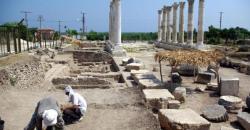 Soli Pompeiopolis - Archaeological fortune of a historical heritage dating back to ancient age, the Soli Pompeiopolis site in Turkey’s southeastern Mersin province, will be researched under water as well, along with ongoing excavation works. Located in Mezitli district, the 3,000-year-old ancient site’s excavation works have been carried out over ground since 1999. However, upon the instruction of Mayor of Mezitli CHP’S Neşet Tarhan, Selçuk University Underwater Archeology research vessel will be working in cooperation with the UNESCO to integrate Soli Pompeiopolis site to its work field next summer, in attempt to extract more artefacts. The site is acknowledged as one of the key ports of the Roman era, dating back to second century B.C., with its 200 pillars between its two doors towards the north and south. Head of the works Professor Remzi Yağcı told the ancient site’s story, saying the site had been submerged into the Mediterranean waters after an earthquake in 525 A.D. According to Yağçı, Soli had hosted many lagans since its construction. Researchers presume that Soli port had been founded by Rhodes pirates who had crossed into Anatolia through Cyprus in 700 B.C. Soli had been later seized by the Roman Empire in 78 B.C., and has been named Soli Pompeiopolis after the Commander Pompei.
Soli Pompeiopolis - Archaeological fortune of a historical heritage dating back to ancient age, the Soli Pompeiopolis site in Turkey’s southeastern Mersin province, will be researched under water as well, along with ongoing excavation works. Located in Mezitli district, the 3,000-year-old ancient site’s excavation works have been carried out over ground since 1999. However, upon the instruction of Mayor of Mezitli CHP’S Neşet Tarhan, Selçuk University Underwater Archeology research vessel will be working in cooperation with the UNESCO to integrate Soli Pompeiopolis site to its work field next summer, in attempt to extract more artefacts. The site is acknowledged as one of the key ports of the Roman era, dating back to second century B.C., with its 200 pillars between its two doors towards the north and south. Head of the works Professor Remzi Yağcı told the ancient site’s story, saying the site had been submerged into the Mediterranean waters after an earthquake in 525 A.D. According to Yağçı, Soli had hosted many lagans since its construction. Researchers presume that Soli port had been founded by Rhodes pirates who had crossed into Anatolia through Cyprus in 700 B.C. Soli had been later seized by the Roman Empire in 78 B.C., and has been named Soli Pompeiopolis after the Commander Pompei.
http://www.dha.com.tr/underwater-soli-pompeiopolis-ancient-site-to-be-brought-to-light_996504.html?
ROYAUME UNI – 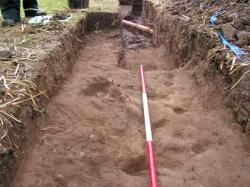 Fulford - Archaeologists investigating the site of the Battle of Fulford, where a Viking army defeated the Saxon troops of Mercia and Northumbria in September 1066, have discovered the ancient road through the ford which gave the village near York its name. A section of clay meeting a peat-filled ditch has revealed more precise points of the conflict and the route the English army retreated along when they were outflanked, according to experts from the Battle of Fulford project which aims to tell the full story of a place which has been at the centre of much debate among historians. “This is clearly the main road heading south from York,” says Chas Jones, the leader of the project. “The alignment suggests that this was the originals A19 linking Main St in Fulford to the route south through Deighton and Lincroft Farm. “It will take a few months to analyse all of the material but there can be no doubt that this road was the axis for the battle fought at the ford in 1066. Many pieces of iron and bits of bone have also been recovered during the dig.
Fulford - Archaeologists investigating the site of the Battle of Fulford, where a Viking army defeated the Saxon troops of Mercia and Northumbria in September 1066, have discovered the ancient road through the ford which gave the village near York its name. A section of clay meeting a peat-filled ditch has revealed more precise points of the conflict and the route the English army retreated along when they were outflanked, according to experts from the Battle of Fulford project which aims to tell the full story of a place which has been at the centre of much debate among historians. “This is clearly the main road heading south from York,” says Chas Jones, the leader of the project. “The alignment suggests that this was the originals A19 linking Main St in Fulford to the route south through Deighton and Lincroft Farm. “It will take a few months to analyse all of the material but there can be no doubt that this road was the axis for the battle fought at the ford in 1066. Many pieces of iron and bits of bone have also been recovered during the dig.
http://www.culture24.org.uk/history-and-heritage/archaeology/art533475-archaeologists-investigating-anglo-viking-battle-fulford-ancient-road-route-of-english-retreat?